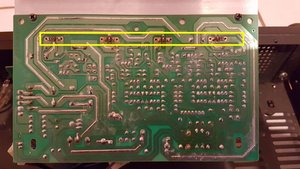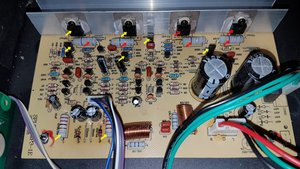Why audio amplifier is blowing fuse?
I have an audio amplifier (FPL 400) which constantly blow its fuse when started. I reproduce it even without speaker connected or audio input source.
The fuse is located just after the power supply cable.
I did tests by isolating some parts. When I disconnect the cable A and B, the fuse blow but when I disconnect the cable C, it didn't blow (see photo). So the cause must be in the main card.


No component of this card seems visually to be degraded, so I don't know which one is defective.
With a multimeter, how can I identify the defective component?
I did my tests with slow fuses, same as provided by the manufacturer (T1AL250V). I also tested the diode bridge after having unsoldered it and it was ok.
Update (07/04/2018)
2 of the transistors looks to be ok (between 0.5 to 0.6 with the diode test). The 2 others ones are both at 0.0v.
Is dit een goede vraag?

 2
2  1
1  2
2 



3 opmerkingen
Usually when fuses pop it’s a capacitor that is shorted out or swelled or leaking!
door CCR Creative Concept Review
RE: CCR
In one word NO!!
Your comment is 100% wrong. There are cases where a leaky capacitor can prevent a power supply from starting, but that is/was not the case here. A bad capacitor in an amplifier circuit such as this is not likely to cause a fuse to blow.
door Abrsvc
If you need more power then amplify it after the mother board and have a electrical control dial so you dont blow a fuse, its possible to make stereo receivers or amps higher watt without making it larger or adding another amp. The components (capacitors, and everything) on the board dont need that much power and thats why there is step down transformers. But you can replace them all with higher watt ones if you want to. If there is already a negative wire connected somewhere then you could probably just run a live wire from the cord to the speaker port but you may not be able to control how loud it goes because speakers pull in as much power as they want. You could position the dial behind your stereo dial so the main one spins both and you can control it from the main dial. Or cover or move it and replace it with the new dial and leave the main one at your desired volume snd the new dial will control the volume.
door Kevin Roe